#their feathers/scales are valued by the scavengers in the region
Explore tagged Tumblr posts
Text

random compulsion to make a custom lizard design eeeeeeee
#been calling it a peacock lizard or pheasant lizard but idk! they're just funky little iridescent guys#they're not very strong but they do a lot of posturing and stuff. like birds of paradise n stuff#their feathers/scales are valued by the scavengers in the region#rain world#rain world fanart#fan design#rain world lizard#wintercat96#rain world art
172 notes
·
View notes
Text
What if people in the whole region are poor subsistence farmers and craftspeople, but they manage a decent standard of life through trading in an usual line of goods…
Directly above them is a huge sprawling magical city in the sky frequented by wizards and adventurers who would never even notice the land below, and certainly never visit - it’s considered the backest of backwaters and rarely even thought about.
Depending on the weather the city is usually invisible/extraplanar so it doesn’t block light from the farmers’ crops. It has a sophisticated sewage and recycling system that requires magic to run, but due to a glitch in the system, if a magical item or material is accidentally thrown out or dropped through a sewer grate, it’s unable to be moved through the system and is ejected from the city’s underside, falling to the countryside below. In a city packed with adventurers and magic users of all kinds, this happens frequently. Magic rings are particularly fond of slipping off people’s fingers and rolling through grates.
The inhabitants of the region are the beneficiaries of a sort of “snow” of magical items falling from the sky. Once every few decades there might be a great big dwarf-forged heavily ensorcelled battleaxe that comes whirling out of the sky, and you certainly hope nobody’s standing underneath it when it does. But for the most part it’s smaller things: enchanted jewellery, wyvern scales, low value gemstones, maybe a potion if it lands in soft grass or a pond instead of shattering on the ground.
The inhabitants of the region collect these windfalls and sell them for lower prices at small local markets or to travelling merchants, after which they are in turn sold at larger markets or taken to cities to be sold for their actual value. It’s not a lot of money for the scavengers, but it’s generally enough for them to buy medicines, small magics and whatever else their region isn’t self-sufficient in. They themselves have few among them with a talent for magic, and only weak magic at that . But their knowledge of magical artifacts and components needs to be vast in order to appraise what they find.
Sometimes birds fly a bit too high underneath the city and the protective magical barrier automatically responds to them as a threat and blasts them with lightning, causing them to die and fall to the ground. Very occasionally a magical creature will meet this end - a sky-serpent, a phoenix, even a pegasus. A whole village will come together to butcher and process the creature - into meat, if edible, but most importantly to extract and clean the magical components - eg. bones, scales, feathers, sometimes a particular gland; it varies between species. Though it’s infrequent, every child must learn the skills and knowledge to properly process a magical creature, so that they’re ready to help if one falls.
But one day a gargantuan sky whale is seen on the horizon, an unusual sight since they normally fly so high they can barely be seen. The whale is beyond ancient, nearing the end of its many eons of natural life. It’s heading to the mountains to die, but it’s left it a bit too late and its strength is already failing, causing it to fly low, low enough to soar beneath the magic city. It’s so close to death that when the automatic protection system triggers, the lightning bolts a healthy sky whale would shrug off are just enough to kill it.
Every part of a sky whale is an extremely valuable magical ingredient. The skin, the oil, the teeth, the bones, the ambergris. A piece of sky whale scrimshaw made millenia ago was a magical artifact powerful enough to change the course of history. And now, this whalefall, this cataclysmic bounty, has fallen right in the center of a land of scavengers who know more or less how to process it, but have no idea how to cope with the changes it will bring.
Low-level Dungeons & Dragons adventure where one of those big goofy skywhale things has died and crash-landed in the middle of town, and what initially appears to be a simple cleanup assignment abruptly takes a combat-heavy turn when the party gets to find out what feeds on skywhalefalls.
18K notes
·
View notes
Text
Neophron percnopterus
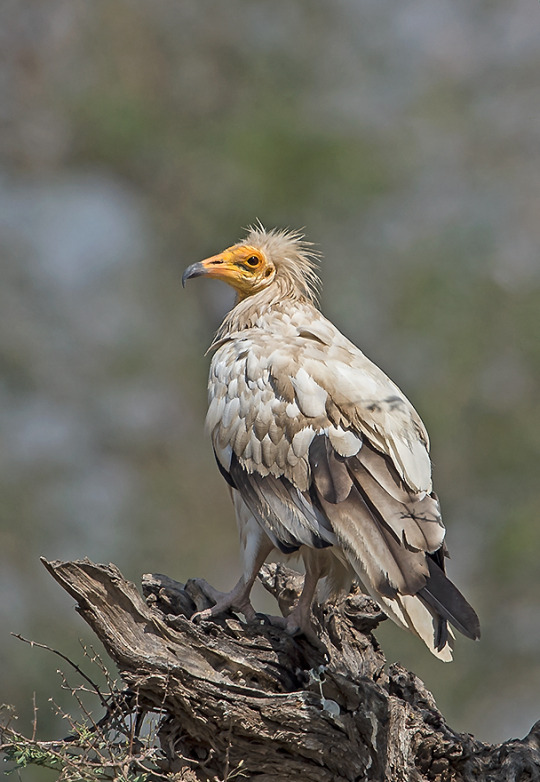
By Koshy Koshy, CC BY 2.0
Etymology: A Childish Trickster
First Described By: Savigny, 1809
Classification: Dinosauromorpha, Dinosauriformes, Dracohors, Dinosauria, Saurischia, Eusaurischia, Theropoda, Neotheropoda, Averostra, Tetanurae, Orionides, Avetheropoda, Coelurosauria, Tyrannoraptora, Maniraptoromorpha, Maniraptoriformes, Maniraptora, Pennaraptora, Paraves, Eumaniraptora, Averaptora, Avialae, Euavialae, Avebrevicauda, Pygostaylia, Ornithothoraces, Euornithes, Ornithuromorpha, Ornithurae, Neornithes, Neognathae, Neoaves, Inopinaves, Telluraves, Afroaves, Accipitrimorphae, Accipitriformes, Accipitridae, Gypaetinae
Status: Extant, Endangered
Time and Place: Since 12,000 years ago, in the Holocene of the Quaternary


Egyptian Vultures are known from locations across India, Western Asia, Africa, and Southern Europe

Physical Description: The Egyptian Vulture is a small vulture, only about 54 to 70 centimeters long with a wingspan of a little more than twice that size. It is also very distinctive in color, and extremely fluffy (which makes sense, given it is probably closely related to the Bearded Vulture). It has a very long and narrow head, which is bare and yellow over the eyes and beak; the tip of the beak is sharply hooked and black. The back of the head and neck is very fluffy and white. The rest of the body is also very puffed, mostly white but with black edges and tips to the wing feathers and tail feathers. It has white fluffy legs, with only some of the feet bear; the feet are pale in color. The females are usually much heavier than the males. The juveniles are significantly darker than the adults in color.
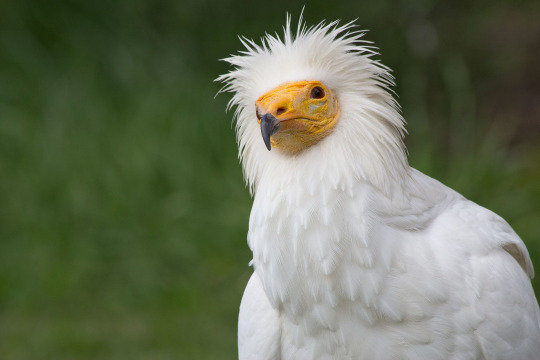
By Carlos Delgado, CC BY-SA 3.0
Diet: Egyptian Vultures primarily feed on large dead animals such as carrion of birds, livestock, wild mammals, and even dogs. Usually it will prefer scraps from large carcasses. Sometimes it will also eat eggs!
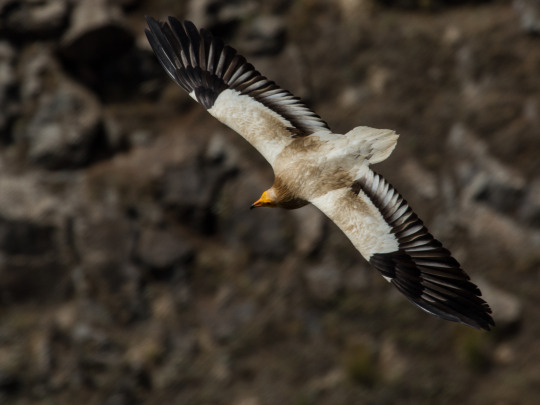
By Вых Пыхманн, CC By-SA 3.0
Behavior: These vultures are pragmatic opportunists, eating a wide variety of carrion that are often rejected by other vulture. It even competes often with crows and other corvids - more pragmatic, intelligent birds! These vultures spend a lot of the day soaring overhead, searching for food from up to one kilometer away; they also will perch and search for food on trees and cliffs. They tend to congregate in large numbers where there is good sources of food - even though this bird is rare. They will pull off chunks of carcass and often will throw stones at eggs to open them up - a documented use of tools! They also will use twigs to roll up and gather strands of wool for nest-lining. They aren’t very loud birds, making small whistles, grunts, groans, and hisses when needed. Somewhat social birds, they are usually found in pairs or in large groups around carcasses, though often they spend time alone.
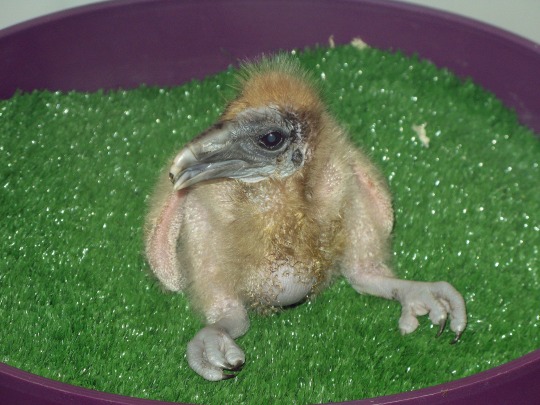
By Jiel, CC BY-SA 4.0
Egyptian Vultures breed in the spring, with pairs courting by soaring high together and then swooping and spiraling down. They are monogamous for at least one breeding season, and may stay with the same mate for many years or even their whole lives. They tend to come back to the same nest sites year after year. They make nests out of twigs and wool, placed on cliff ledges and on large tree forks. Neighboring birds may form polyamorous groups with a mated pair, allowing for the two pairs of adults to aid each other in caring for the young. Usually the birds prepare for copulation by giving each other food, and preening each other to get in the “mood”. They lay around two eggs usually, which are incubated for around one and a half months. All adults will incubate the chicks, which are very brown and puffy. They stay in the nest for up to three months, cared for by the parents for most of that time. They reach sexual maturity between 4 and 6 years of age, and can live for nearly four decades, though most tend to die by the fifth year of life in the wild.
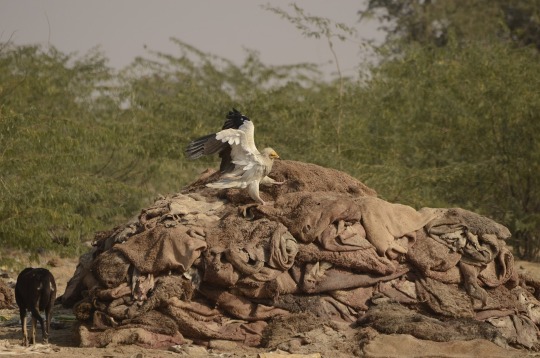
By PJeganathan, CC BY-SA 4.0
The vultures tend to soar on thermal wind, using the heat to raise themselves higher in the air; on the land they’re much less graceful, waddling around awkwardly. They are very calculating animals, waiting for predators to leave a carcass before approaching. They’ll even feed on poop to get carotenoids - pigments - from large herbivorous mammals. They tend to migrate only in the northern part of their range - in Africa and India, they stay mainly in the same location year-round. They glide extensively while flying, wasting as little energy while migrating as possible.
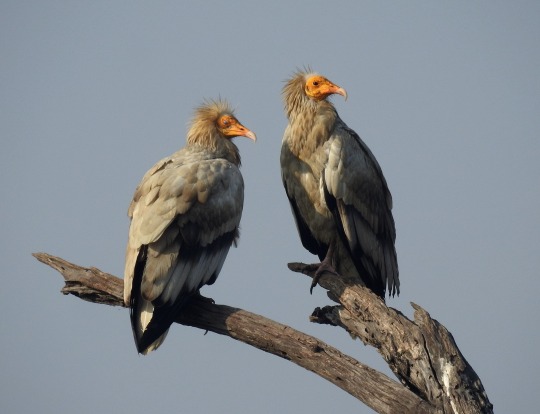
By Dr. Raju Kasambe, CC BY-SA 4.0
Ecosystem: Egyptian Vultures prefer open areas, preferably ones with dry and arid habitat. They especially prefer locations near cold and wet climates, such as scrub habitats. They also frequent deserts, steppes, pastures, and some fields, though they try to stay near rocky places when nesting. They also can be found in mountainous regions at lower or mid-level altitudes. They are hunted upon by golden eagles, eagle owls, and red foxes as young; they also are very vulnerable to other mammalian predators (like wolves) as adults and to human interference. In fact, human activity takes a toll on population size.
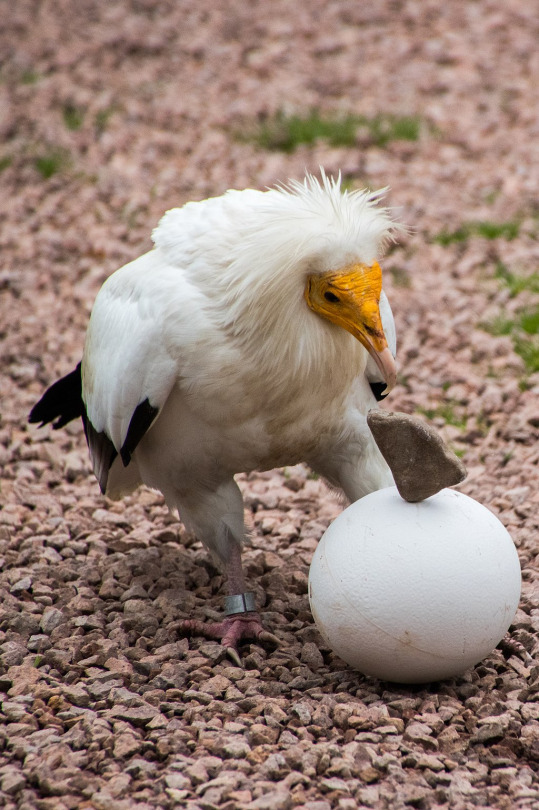
By Tomasz Baranowski, CC BY 2.0
Other: Egyptian Vultures have gone through extensive population decline, though in some locations the population is more stable now and recovering. They are greatly affected by human activity, including things such as power lines and hunting, intentional poisoning, and superstition-based activity. Since vultures are considered harbingers of doom, people tend to be afraid of them - and they aren’t always the prettiest birds, so people don’t feel emotional attachment to them enough to avoid killing them. Declines in herding and livestock maintenance among humans also has lead to some population decline. Combinations of these factors in many countries make conservation efforts difficult to implement. Some attempts to preserve this vulture have included “vulture restaurants”, where carcasses are made available to vultures nearby.
~ By Meig Dickson
Sources Under the Cut
Agarwal, G.P.; Ahmad, Aftab; Arya, Gaurav; Saxena, Renu; Nisar, Arjumand; Saxena, A.K. (2012). "Chaetotaxy of three nymphal instars of an ischnoceran louse, Aegypoecus perspicuus (Phthiraptera: Insecta)". Journal of Applied and Natural Science. 4 (1): 92–95.
Agostini, Nicolantonio; Premuda, Guido; Mellone, Ugo; Panuccio, Michele; Logozzo, Daniela; Bassi, Enrico; Cocchi, Leonardo (2004). "Crossing the sea en route to Africa: Autumn migration of some Accipitriformes over two Central Mediterranean islands". The Ring. 26 (2): 71–78.
Agudo, Rosa; Rico, Ciro; Vilà, Carles; Hiraldo, Fernando; Donázar, José (2010). "The role of humans in the diversification of a threatened island raptor". BMC Evolutionary Biology. 10: 384.
Ali, Sálim; Ripley, Sidney Dillon (1978). Handbook of the birds of India and Pakistan. Volume 1 (2nd ed.). Oxford University Press. pp. 310–314.
Amadon, D. 1977. Notes on the taxonomy of vultures. Condor 79(4):413-416
Amezian, M.; El Khamlichi, K. (2016). "Significant population of Egyptian Vulture Neophron percnopterus found in Morocco". Ostrich. 87 (1): 73–76.
Angelov, Ivaylo; Hashim, Ibrahim; Oppel, Steffen (2012). "Persistent electrocution mortality of Egyptian Vultures Neophron percnopterus over 28 years in East Africa". Bird Conservation International. 23: 1–6.
Baker, E.C. Stuart (1928). The Fauna of British India. Birds. Volume 5 (2nd ed.). London: Taylor and Francis. pp. 22–24.
Baxter, R. M.; Urban, E. K.; Brown, L. H (1969). "A Nineteenth-century reference to the use of tools by the Egyptian vulture". Journal of the East Africa Natural History Society and National Museum. 27 (3): 231–232.
Biddulph, C.H. (1937). "Unusual site for the nest of the White Scavenger Vulture Neophron percnopterus ginginianus (Lath.)". The Journal of the Bombay Natural History Society. 39 (3): 635–636.
Byrd, Brooke. "Of Love and Loathing: The Role of the Vulture in Three Cultures". Prized Writing: 81–93.
Carrete, Martina; Sánchez-Zapata, José A.; Benítez, José R.; Lobón, Manuel; Donázar, José A. (2009). "Large scale risk-assessment of wind-farms on population viability of a globally endangered long-lived raptor". Biological Conservation. 142 (12): 2954–2961.
Ceballos, Olga; Donázar, José Antonio (1990). "Roost-tree characteristics, food habits and seasonal abundance of roosting Egyptian Vultures in northern Spain". Journal of Raptor Research. 24 (1–2): 19–25.
Ceballos, Olga; Donázar, José Antonio (1989). "Factors influencing the breeding density and nest-site selection of Egyptian vulture (Neophron percnopterus)". Journal of Ornithology. 130 (3): 353–359.
Clark, William S.; Schmitt, N.J. (1998). "Ageing Egyptian Vultures". Alula. 4: 122–127.
Clements, J. F., T. S. Schulenberg, M. J. Iliff, D. Roberson, T. A. Fredericks, B. L. Sullivan, and C. L. Wood. 2017. The eBird/Clements checklist of birds of the world: v2017
Cortés-Avizanda, A.; Carrete, M.; Serrano, D.; Donázar, J.A. (2009). "Carcasses increase the probability of predation of ground-nesting birds: a caveat regarding the conservation value of vulture restaurants”. Animal Conservation. 12: 85–88.
Cortés-Avizanda, Ainara; Ceballos, Olga; Donázar, José A. (2009). "Long-Term Trends in Population Size and Breeding Success in the Egyptian Vulture (Neophron percnopterus) in Northern Spain". Journal of Raptor Research. 43 (1): 43–49.
Coultas, Harland (1876). Zoology of the Bible. London: Wesleyan Conference Office.
Cuthbert, R.; Green, R.E.; Ranade, S.; Saravanan, S.; Pain, D.J.; Prakash, V.; Cunningham, A.A. (2006). "Rapid population declines of Egyptian vulture (Neophron percnopterus) and red-headed vulture (Sarcogyps calvus) in India". Animal Conservation. 9 (3): 349–354.
Dewar, Douglas (1906). Bombay Ducks. John Lane, London. p. 277.
Donázar, José Antonio; Ceballos, Olga (1989). "Growth rates of nestling Egyptian Vultures Neophron percnopterus in relation to brood size, hatching order and environmental factors". Ardea. 77 (2): 217–226.
Donázar, Jose A.; Ceballos, Olga (1988). "Red fox predation on fledgling Egyptian vultures". Journal of Raptor Research. 22 (3): 88.
Donázar, José Antonio; Ceballos, Olga (1989). "Post-fledging dependence period and development of flight and foraging behaviour in the Egyptian Vulture Neophron percnopterus". Ardea. 78 (3): 387–394.
Donázar, José A.; Ceballos, Olga (1990). "Acquisition of food by fledgling Egyptian Vultures Neophron percnopterus by nest-switching and acceptance by foster adults". Ibis. 132 (4): 603–607.
Donázar, José A.; Ceballos, Olga; Tella, José L. (1994). "Copulation behaviour in the Egyptian Vulture Neophron percnopterus". Bird Study. 41 (1): 37–41.
Donázar, José A.; Ceballos, Olga; Tella, José L. (1996). "Communal roosts of Egyptian vultures (Neophron percnopterus): dynamics and implications for the species conservation". In Muntaner, J. (ed.). Biology and Conservation of Mediterranean Raptors. Monografía SEO-BirdLife, Madrid. pp. 189–201.
Donázar, José A.; Palacios, César J.; Gangoso, Laura; Ceballos, Olga; González, Maria J.; Hiraldo, Fernando (2002). "Conservation status and limiting factors in the endangered population of Egyptian vulture (Neophron percnopterus) in the Canary Islands". Biological Conservation. 107 (1): 89–97.
Donázar, José Antonio; Negro, Juan José; Palacios, César Javier; Gangoso, Laura; Godoy, José Antonio; Ceballos, Olga; Hiraldo, Fernando; Capote, Nieves (2002). "Description of a new subspecies of the Egyptian Vulture (Accipitridae: Neophron percnopterus) from the Canary Islands". Journal of Raptor Research. 36 (1): 17–23.
Elorriaga, Javier; Zuberogoitia, Iñigo; Castillo, Iñaki; Azkona, Ainara; Hidalgo, Sonia; Astorkia, Lander; Ruiz-Moneo, Fernando; Iraeta, Agurtzane (2009). "First Documented Case of Long-Distance Dispersal in the Egyptian Vulture (Neophron percnopterus)". Journal of Raptor Research. 43 (2): 142–145.
Ferguson-Lees, James; Christie, David A. (2001). Raptors of the World. Christopher Helm. pp. 417–420.
Galushin, V.M. (1975). "A comparative analysis of the density of predatory birds in two selected areas within the Palaearctic and Oriental regions, near Moscow and Delhi (IOC Abstracts)". Emu. 74 (5): 331.
Galushin, V. M. (2001). "Populations of vultures and other raptors in Delhi and neighboring areas from 1970's to 1990's". In Parry-Jones, J.; Katzner, T. (eds.). Report from the Workshop on Indian Gyps vultures: 4th Eurasian congress on raptors. Sevilla, Spain: aviary.org. pp. 13–15.
Gangoso, Laura (2005). "Ground nesting by Egyptian Vultures (Neophron percnopterus) in the Canary Islands". Journal of Raptor Research. 39 (2): 186–187.
Gangoso, Laura; Álvarez-Lloret, Pedro; Rodríguez-Navarro, Alejandro A. B.; Mateo, Rafael; Hiraldo, Fernando; Donázar, José Antonio (2009). "Long-term effects of lead poisoning on bone mineralization in vultures exposed to ammunition sources". Environmental Pollution. 157 (2): 569–574.
García-Ripollés, Clara; López-López, Pascual (2006). Penteriani, Vincenzo (ed.). "Population size and breeding performance of Egyptian vultures (Neophron percnopterus) in eastern Iberian Peninsula". Journal of Raptor Research. 40 (3): 217–221.
García-Ripollés, Clara; López-López, Pascual; Urios, Vicente (2010). "First description of migration and wintering of adult Egyptian Vultures Neophron percnopterus tracked by GPS satellite telemetry". Bird Study. 57 (2): 261–265.
Grande, Juan M.; Serrano, David; Tavecchia, Giacomo; Carrete, Martina; Ceballos, Olga; Díaz-Delgado, Ricardo; Tella, José L.; Donázar, José A. (2009). "Survival in a long-lived territorial migrant: effects of life-history traits and ecological conditions in wintering and breeding areas". Oikos. 118 (4): 580–590.
Grimal, Pierre (1996). The dictionary of classical mythology. Wiley-Blackwell. p. 18.
Hartert, Ernst (1920). Die Vögel der paläarktischen Fauna. Volume 2. Berlin: Friendlander & Sohn. pp. 1200–1202.
Hernández, Mauro; Margalida, Antoni (2009). "Poison-related mortality effects in the endangered Egyptian vulture (Neophron percnopterus) population in Spain". European Journal of Wildlife Research. 55 (4): 415–423.
Hertel, Fritz (1995). "Ecomorphological indicators of feeding behavior in recent and fossil raptors". The Auk. 112 (4): 890–903.
Hidalgo, S.; Zabala, J.; Zubergoitia, I.; Azkona, A.; Castillo, I. (2005). "Food of the Egyptian vulture (Neophron percnopterus) in Biscay". Buteo. 14: 23–29.
Ingerson, Ernest (1923). Birds in legend, fable and folklore. New York: Longmans, Green and Co.
Jardine, William; Selby, Prideaux John (1826). Illustrations of ornithology. Volume 1. Edinburgh: W.H. Lizars.
Jaume, D., M. McMinn, and J. A. Alcover. 1993. Fossil birds from the Bujero del Silo, La Gomera (Canary Islands), with a description of a new species of quail (Galliformes: Phasianidae). Boletim do Museu Municipal do Funchal 2:147-165
Jobling, J. A. 2010. The Helm Dictionary of Scientific Bird Names. Christopher Helm Publishing, A&C Black Publishers Ltd, London.
Koenig, Alexander (1907). "Die Geier Aegyptens" [The Egyptian vulture]. Journal für Ornithologie (in German). 55: 59–134.
Kretzmann, Maria B.; Capote, N.; Gautschi, B.; Godoy, J.A.; Donázar, J.A.; Negro, J.J. (2003). "Genetically distinct island populations of the Egyptian vulture (Neophron percnopterus)". Conservation Genetics. 4 (6): 697–706.
Latham, John (1787). Supplement to the General Synopsis of birds. London: Leigh & Sotheby. p. 7.
Liberatori, Fabio; Penteriani, Vincenzo (2001). "A long-term analysis of the declining population of the Egyptian vulture in the Italian peninsula: distribution, habitat preference, productivity and conservation implications". Biological Conservation. 101 (3): 381–389.
Linnaeus, C. 1758. Systema Naturae per Regna Tria Naturae, Secundum Classes, Ordines, Genera, Species, cum Characteribus, Differentiis, Synonymis, Locis. Editio Decima 1:1-824
Margalida, A.; Benítez, J.R.; Sánchez-Zapata, J.A.; Ávila, E.; Arenas, R.; Donázar, J.A. (2012). "Long-term relationship between diet breadth and breeding success in a declining population of Egyptian Vultures Neophron percnopterus". Ibis. 154: 184–188.
Margalida, Antoni; Boudet, Jennifer (2003). "Dynamics and temporal variation in age structure at a communal roost of egyptian vultures (Neophron percnopterus) in northeastern Spain". Journal of Raptor Research. 37 (3): 252–256.
Peters, James L. (1979). Mayr, Ernst; Cottrell, G.W. (eds.). Check-list of birds of the world. Volume 1 (2nd ed.). Cambridge, Massachusetts: Museum of Comparative Zoology. p. 304.
Mateo, Patricia; Olea, Pedro P. (2007). "Egyptian Vultures (Neophron percnopterus) Attack Golden Eagles (Aquila chrysaetos) to Defend their Fledgling". Journal of Raptor Research. 41 (4): 339–340.
Meyburg, Bernd-U.; Gallardo, Max; Meyburg, Christiane; Dimitrova, Elena (2004). "Migrations and sojourn in Africa of Egyptian vultures (Neophron percnopterus) tracked by satellite". Journal of Ornithology. 145 (4): 273–280.
Mundy, P.J. (1978). "The Egyptian vulture (Neophron Percnopterus) in Southern Africa". Biological Conservation. 14 (4): 307–315.
Neelakantan, K.K. (1977). "The sacred birds of Thirukkalukundram". Newsletter for Birdwatchers. 17 (4): 6.
Negro, J.J.; Grande, J.M.; Tella, J.L.; Garrido, J.; Hornero, D.; Donázar, J.A.; Sanchez-Zapata, J.A.; Benítez, J.R.; Barcell, M. (2002). "Coprophagy: An unusual source of essential carotenoids". Nature. 416 (6883): 807–808.
Orta, J., Kirwan, G.M., Christie, D.A., Garcia, E.F.J. & Marks, J.S. (2019). Egyptian Vulture (Neophron percnopterus). In: del Hoyo, J., Elliott, A., Sargatal, J., Christie, D.A. & de Juana, E. (eds.). Handbook of the Birds of the World Alive. Lynx Edicions, Barcelona.
Palacios, César-Javier (2004). "Current status and distribution of birds of prey in the Canary Islands". Bird Conservation International. 14 (3).
Palacios, César-Javier (2000). "Decline of the Egyptian vulture (Neophron percnopterus) in the Canary Islands". Journal of Raptor Research. 34 (1): 61.
Paynter, W.P. (1924). "Lesser White Scavenger Vulture N. ginginianus nesting on the ground". The Journal of the Bombay Natural History Society. 30 (1): 224–225.
Pope, G.U. (1900). The Tiruvacagam or Sacred utterances of the Tamil poet, saint, and sage Manikka-vacagar. Oxford: Clarendon Press.
Prakash, Vibhu; Nanjappa, C. (1988). "An instance of active predation by Scavenger Vulture (Neophron p. ginginianus) on Checkered Keelback watersnake (Xenochrophis piscator) in Keoladeo National Park, Bharatpur, Rajasthan". The Journal of the Bombay Natural History Society. 85 (2): 419.
Rasmussen, P.C.; Anderton, J.C. (2005). Birds of South Asia: The Ripley Guide. Volume 2. Smithsonian Institution and Lynx Edicions. p. 89.
Seibold, I.; Helbig, A.J. (1995). "Evolutionary History of New and Old World Vultures Inferred from Nucleotide Sequences of the Mitochondrial Cytochrome b Gene". Philosophical Transactions of the Royal Society B: Biological Sciences. 350 (1332): 163–178.
Siromoney, Gift (1977). "The Neophron Vultures of Thirukkalukundram". Newsletter for Birdwatchers. 17 (6): 1–4.
Spaar, Reto (1997). "Flight strategies of migrating raptors; a comparative study of interspecific variation in flight characteristics". Ibis. 139 (3): 523–535.
Stoyanova, Yva; Stefanov, Nikolai (1993). "Predation upon nestling Egyptian Vultures (Neophron percnopterus) in the Vratsa Mountains of Bulgaria". Journal of Raptor Research. 27 (2): 123.
Stoyanova, Yva; Stefanov, Nikolai; Schmutz, Josef K. (2010). "Twig Used as a Tool by the Egyptian Vulture (Neophron percnopterus)". Journal of Raptor Research. 44 (2): 154–156.
Suárez-Pérez, A.; Ramírez, A.S.; Rosales, R.S.; Calabuig, P.; Poveda, C.; Rosselló-Móra, R.; Nicholas, R.A.J.; Poveda, J.B. (2012). "Mycoplasma neophronis sp. nov., isolated from the upper respiratory tract of Canarian Egyptian vultures (Neophron percnopterus majorensis)". International Journal of Systematic and Evolutionary Microbiology. 62 (Pt 6): 1321–1325.
Stratton-Porter, Gene (1909). Birds of the Bible. Cincinnati: Jennings and Graham. p. 182.
Tauler-Ametller, H.; Hernández-Matías, A.; Pretus, J. L.L.; Real, J. (2017). "Landfills determine the distribution of an expanding breeding population of the endangered Egyptian Vulture Neophron percnopterus". Ibis. 159 (4): 757–768.
Tella, José Luis (1993). "Polyandrous trios in a population of Egyptian vultures (Neophron percnopterus)". Journal of Raptor Research. 27 (2): 119–120.
Tella, José L.; Mañosa, Santi (1993). "Eagle owl predation on Egyptian vulture and northern goshawk: possible effect of a decrease in European rabbit availability". Journal of Raptor Research. 27 (2): 111–112.
Thompson, D'Arcy Wentworth (1895). A glossary of Greek birds. Oxford: Clarendon Press.
Thouless, C.R.; Fanshawe, J.H.; Bertram, B.C.R. (1989). "Egyptian Vultures Neophron percnopterus and Ostrich Struthio camelus eggs: The origins of stone-throwing behaviour". Ibis. 131: 9–15.
Thurston, E.W. (1906). Ethnographic notes in southern India. Madras: Government Press.
van Lawick-Goodall, Jane; van Lawick, Hugo (1966). "Use of Tools by the Egyptian Vulture, Neophron percnopterus". Nature. 212 (5069): 1468–1469.
van Overveld, T.; de la Riva, M.; Donázar, J. A. (2017). "Cosmetic coloration in Egyptian vultures: Mud bathing as a tool for social communication?". Ecology. 98 (8): 2216–2218.
Whistler, Hugh (1949). Popular Handbook of Indian Birds (4th ed.). London: Gurney & Jackson. pp. 356–357.
Whistler, Hugh (1922). "The birds of Jhang district, S.W.Punjab. Part II. Non-Passerine birds". Ibis. 64 (3): 401–437.
Wink, Michael (1995). "Phylogeny of Old and New World Vultures (Aves: Accipitridae and Cathartidae) Inferred from Nucleotide Sequences of the Mitochondrial Cytochrome b Gene". Zeitschrift für Naturforschung C. 50 (11/12): 868–882.
Wink, Michael; Heidrich, Petra; Fentzloff, Claus (1996). "A mtDNA phylogeny of sea eagles (genus Haliaeetus) based on nucleotide sequences of the cytochrome b-gene". Biochemical Systematics and Ecology. 24 (7–8): 783–791.
Yosef, Reuven; Alon, Dan (1997). "Do immature Palearctic Egyptian Vultures Neophron percnopterus remain in Africa during the northern summer?". Vogelwelt. 118: 285–289.
Zarudny, V.; Härms, M. (1902). "Neue Vogelarten". Ornithologische Monatsberichte (in German) (4): 49–55.
#Neophron percnopterus#Neophron#Vulture#Egyptian Vulture#Dinosaur#Dinosaurs#Bird of Prey#Bird#Birds#Raptor#Pharaoh's Chicken#White Scavenger Vulture#Quaternary#Eurasia#Africa#India & Madagascar#Carnivore#Theropod Thursday#Accipitrimorph#biology#a dinosaur a day#a-dinosaur-a-day#dinosaur of the day#dinosaur-of-the-day#science#nature#factfile#birblr
184 notes
·
View notes